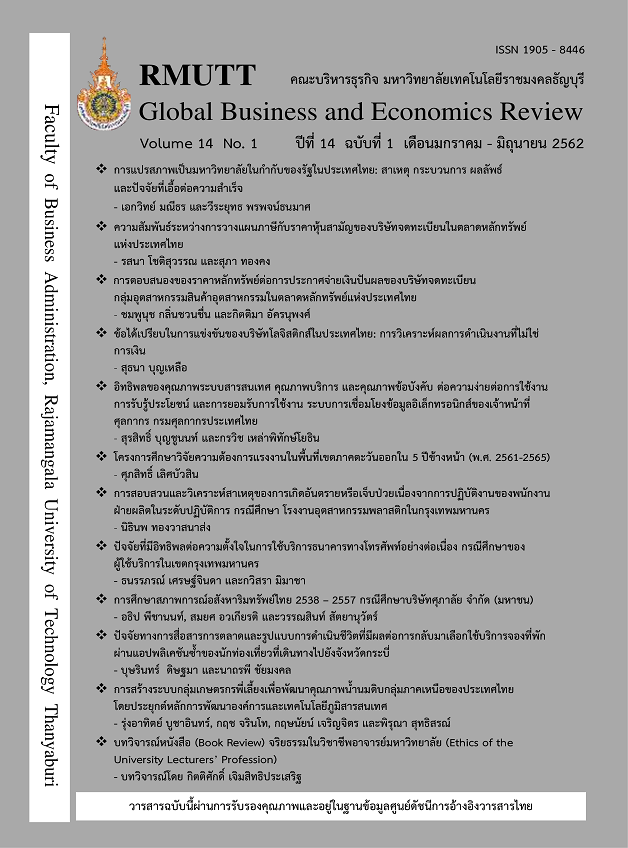QUALITY IMPROVEMENT SYSTEM OF RAW MILK BY MENTOR GROUP IN THE NORTHERN OF THAILAND USING INTEGRATION OF ORGANIZATION DEVELOPMENT AND GEOINFORMATICS
Keywords:
Milk Quality Development, Mentor System, High-Precision Agriculture, Geo-Informatics TechnologyAbstract
This research is an integrated research using the science of geospatial science, which is a science and business administration, with the objectives of the research project is 1) to increase the potential of dairy farmers which will result in increasing quality of raw milk and develop a system more efficient and sustainable. 2) to create a geo-informatics database and to analyze the suitable area for growing crops nearby dairy cattle to support farmers Group. It is an action research by applying the principles of organizational development and geo-informatics technology that has followed the steps of the research methodology in stages 1 through 6, by selecting 18 sample farms from the northern region. The raw milk quality is improved in term of statistical significance. The project has suggested as follows: 1) Attitude to raising cattle when attending training and believing is very important, in what the instructor told and followed. If the trainee obeys, the result after training is better milk quality with statistical significance. Therefore, the development of "people" is necessary to select people who are ready to receive knowledge and want to change. Moreover, the trainees should be able to use technology 2) Applied for precision farming or Precision Agriculture related to dairy farming in this research is to find food sources such as Grasses in nearby areas and may be further expanded, such as the tags of a cattle identification system to study the walk of each cow, which results in further health of the cattle 3) The farmer should use the basic information technology, such as application cow care 4.0 can then lead to data collection of all cattle farming for analysis used to manage the farm completely, for example Cattle information from birth, breeding animals, warning systems to artificial insemination, quantity of milk, quality of milk , health of cows, illness and others to be in the form of big data, for the owners of dairy farms to plan, including the overall country 4) The 1st generation cattle farmers must be acting as mentors, giving advice and bringing the knowledge to tell other entrepreneurs or farm owners nearby or in the same cooperative.
References
เกรียงศักดิ์ เทพผดุงพร. (2557). รูปแบบวัฒนธรรมพี่เลี้ยงที่เหมาะสมในการพัฒนาองค์การ. (ดุษฏีนิพนธ์ ปรัชญาดุษฎีบัณฑิต, มหาวิทยาลัยบูรพา).
กรุงเทพธุรกิจ. (2557). อุตสาหกรรมนมไทยเข้าขั้นวิกฤตขาดแคลนน้ำนมดิบ. สืบค้นจาก https://shorturl.at/anrFJ
สำนักงานเศรษฐกิจการเกษตร. (2558). จำนวนโคนมและปริมาณน้ำนมดิบ. ใน สถิติการเกษตรของประเทศไทย ปี 2558. (น. 108-116).
อังคณา สมศักดิ์ และวาสนา วิรุญรัตน์. (2559). การประเมินที่ดินบนฐานระบบสารสนเทศภูมิศาสตร์ผลิตหญ้าเลี้ยงสัตว์พันธุ์เนเปียร์ปากช่อง 1 อำเภอแม่ออน จังหวัดเชียงใหญ่. วารสารวิทยาศาสตร์เกษตร, 47(2), 273-276.
Harrison, R. & Kessels, J. W. M. (2004). Human resource development in a knowledge economy: an organisational view. Houndmills, Basingstoke, Hampshire; New York:Palgrave Macmillan.
Kemmis, S. & McTaggart, R. (1988). The Action research planer (3rd ed.). Victoria: Deakin University.
Swanson, R. A. & Holton, E. F. (2009). Executive coaching: an integrative literature review, foundations of human resource development (2nd ed). San Francisco: Berrett-Koehler.
Downloads
Published
How to Cite
Issue
Section
License
The articles published in this journal are the intellectual property of their respective authors.
The views and opinions expressed in each article are solely those of the individual authors and do not reflect the positions of Rajamangala University of Technology Thanyaburi or any of its faculty members. All components and content of each article are the sole responsibility of the respective authors. In the event of any errors, the authors shall bear full responsibility for their own work.








